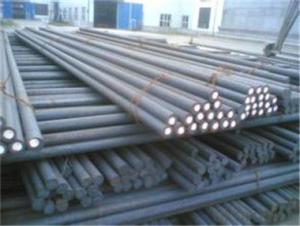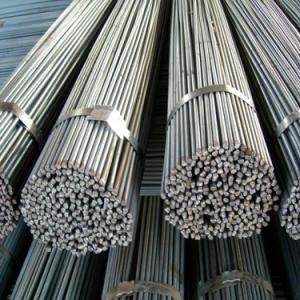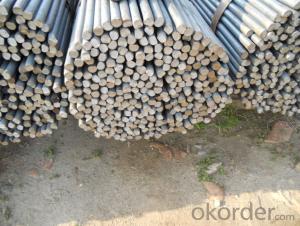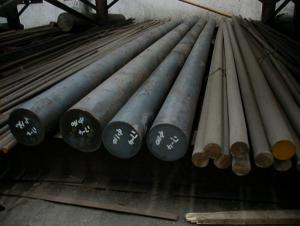Round Bar Manufacturer for Constructure with High Quality
- Loading Port:
- Tianjin
- Payment Terms:
- TT OR LC
- Min Order Qty:
- 200 m.t.
- Supply Capability:
- 2000000 m.t./month
OKorder Service Pledge
OKorder Financial Service
You Might Also Like
Item specifice
Description of steel round bar:
(1) Thickness of not more than 2MM sheet, efficient blanking die, punch die and pressure die etc(2) All kinds of scissors, inserts, woodworking blade.
(3) Thread rolling die and wear-resistant slider.
(4) Cold Heading Die, thermosetting resin molding.
(5) Molding in deep drawing cold extrusion dies
Festures of steel round bar:
Mainly used for engineering component, forging industries, foundation bolt, shafting etc
We also stock RINL make rounds from 16mm to 80mm in all the available grades
We also take special orders in EN8, EN9 or any other equivalent grade with specific dimensional requirementsThe data given above in chart are indicative. Actual results may vary.
BS 4449:1997 (Gr 250, Gr 460 A, Gr 460 B)
ASTM A615/A615M-08 (Grade 40, Grade 60)
TCVN 1651-1985 ( CI, CII, CIII, CIV )
Specifications of steel round bar:
Description | steel round bar | |
Material | ASTM /AISI | 0,1065,1070,1080,1084 |
DIN | 5,1.7220,1.7218,1.7016,1.6523 | |
Standard | ,A575,BS970,DIN1652,JIS G4051 | |
cross section | Round Other shape:square | |
Surface | Black, galvanized,grinded,varnished,bare | |
Specifications | Round bar | Diameter: 12mm~650mm |
Angle bar | Size: 3mm*20mm*20mm | |
Square/ bar | Size: 4mm*4mm | |
Flat bar | Thickness: 2mm~100mm | |
Width:10mm~500mm | ||
Hexagonal | Size: 4mm~800mm | |
Length | Standard 6m,9m,12m or as required. | |
Trade terms | Payment terms | T/T,L/C,Western Union,negotiable etc. |
Price terms | FOB,CIF,CFR,EXW etc. | |
Applications | Hot rolled Steel round bars have a slightly grain textured finish. | |
Images of steel round bar:
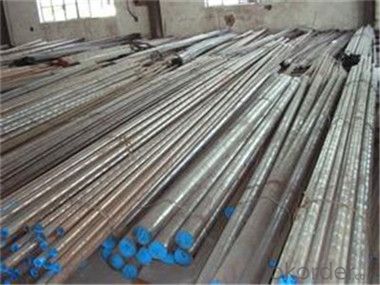
FAQ:
1. What is your package?
Packing situation: standard seaworthy packing or as customer required.
2. How long is the lead time?
Delivery time: 45 days after order confirmed.
3. What payment term do you accept?
Payment: T/T or L/C at sight.
- Q:Can steel round bars be used in the manufacturing of appliances?
- Yes, steel round bars can be used in the manufacturing of appliances. Steel is a durable and versatile material that can be shaped into different forms, including round bars, which can be used for various purposes in appliance manufacturing such as structural support, handles, or components.
- Q:How are steel round bars used in the construction of pipelines?
- Steel round bars are commonly used in the construction of pipelines due to their high strength and durability. These bars are typically made from carbon or alloy steel and are available in various sizes and grades to suit the specific requirements of the pipeline. One of the key uses of steel round bars in pipeline construction is for reinforcement. They are often used as reinforcement in concrete foundations and supports along the pipeline route. The bars provide added strength and stability to the structure, ensuring that the pipeline remains secure and can withstand external forces such as soil movement or seismic activity. Additionally, steel round bars are also used as the main material for the fabrication of pipeline joints. These bars are typically bent or welded to form various shapes and sizes to connect different sections of the pipeline. The high tensile strength of steel ensures that the joints can withstand the pressure and stress exerted by the fluids being transported through the pipeline. Moreover, steel round bars are utilized in the construction of pipeline hangers and supports. These bars are often shaped and welded to form brackets or clamps that hold the pipeline in place. The bars provide a sturdy and reliable support system, preventing sagging or movement of the pipeline, and ensuring smooth and uninterrupted flow. In summary, steel round bars play a crucial role in the construction of pipelines. They are used for reinforcement, fabrication of pipeline joints, and the construction of hangers and supports. Their high strength, durability, and versatility make them an ideal choice for ensuring the structural integrity and reliability of pipelines.
- Q:How do steel round bars perform in low-temperature environments?
- Low-temperature environments are typically suitable for steel round bars, as they tend to perform well in such conditions. The mechanical properties of steel, including strength and toughness, are usually maintained even at low temperatures. However, it is crucial to consider the grade of steel being used, as certain grades may exhibit reduced impact resistance or brittleness when subjected to extremely low temperatures. One common concern is the possibility of brittle fracture occurring in steel round bars under low-temperature circumstances. This can happen when the steel undergoes a transition from a ductile to a brittle state. Nevertheless, most standard steel grades employed in construction and industry are designed to resist brittle fracture even in low-temperature environments. Certain special alloy steels, such as low-temperature carbon steels, are specifically formulated to exhibit superior performance in extremely cold conditions. These steels contain additional elements, such as nickel or manganese, which enhance their low-temperature properties. They are frequently utilized in applications that require exceptional toughness and impact resistance, such as offshore structures or cryogenic storage tanks. In conclusion, steel round bars generally exhibit good performance in low-temperature environments while maintaining their mechanical properties. However, it is essential to carefully select the appropriate steel grade for the specific low-temperature application in order to ensure optimal performance and prevent potential issues like brittle fracture.
- Q:How do you measure the straightness tolerance of a steel round bar?
- To measure the straightness tolerance of a steel round bar, you can use a variety of methods depending on the accuracy and precision required. Here are a few common techniques: 1. Visual Inspection: This is a simple method where you visually inspect the bar for any visible deviations from straightness. You can place the bar on a flat surface and look for any bends or curves along its length. However, this method is subjective and may not provide precise measurements. 2. Straightedge Method: In this method, you place a straightedge, such as a ruler or a precision straightedge, against the bar's surface and check for any gaps or spaces between the straightedge and the bar. This method provides a more accurate measurement but can still be influenced by human error. 3. Dial Indicator Method: This method involves using a dial indicator, which is a precision measuring tool, to measure the straightness tolerance. You secure the dial indicator to a fixed point and then move it along the length of the bar, noting any deviations from a straight line. This method provides more precise measurements and can be used to quantify the straightness tolerance in terms of a specific unit of measurement, such as inches or millimeters. 4. Laser Measurement: Laser systems, such as laser alignment devices, can be used to measure the straightness tolerance of a steel round bar. These systems use lasers to project a straight line onto the surface of the bar and then measure any deviations from this line. Laser measurement provides highly accurate and repeatable results, making it suitable for applications that require tight tolerances. It is important to note that the choice of measurement method depends on the required accuracy, the size of the round bar, and the available resources and equipment. Additionally, it is recommended to consult industry standards and guidelines to ensure compliance with specific tolerances and requirements for your application.
- Q:Can steel round bars be used in the production of electrical equipment?
- Yes, steel round bars can be used in the production of electrical equipment. Steel is a versatile material with various properties that make it suitable for different applications, including electrical equipment. Steel round bars can be used to manufacture components such as shafts, connectors, and structural supports in electrical equipment. The strength and durability of steel make it a reliable choice for these applications, as it can withstand the mechanical stresses and environmental conditions that electrical equipment may be exposed to. Additionally, steel can provide good electrical conductivity and magnetic properties, which are important characteristics for certain electrical components. However, it is worth noting that steel round bars may need to undergo additional processes such as machining, heat treatment, or surface finishing to meet specific requirements for electrical equipment production.
- Q:What are the common applications of steel round bars?
- Steel round bars are highly valued in various industries because of their strength, versatility, and durability. They find widespread use in different sectors, including construction, manufacturing, automotive, aerospace, energy and power, and the oil and gas industry. In construction, steel round bars are commonly employed for building frames, bridges, and infrastructure, providing structural support and withstanding heavy loads. They are also frequently used to reinforce concrete structures, enhancing their strength and resilience. The manufacturing industry relies on steel round bars for the production of various components and machinery. Gears, shafts, couplings, and axles are commonly fabricated using these bars due to their excellent machinability and ability to withstand high levels of stress and pressure. Within the automotive sector, steel round bars are extensively used to manufacture critical components such as crankshafts, steering systems, suspension parts, and axles. Their high tensile strength and resistance to wear and tear play a crucial role in ensuring the safety and reliability of vehicles. The aerospace industry heavily depends on steel round bars for the production of aircraft components, including landing gear, propeller shafts, and structural elements. Steel's high strength-to-weight ratio and exceptional fatigue resistance make it an ideal choice for withstanding the extreme conditions experienced in aerospace applications. In the energy and power sector, steel round bars are employed in the manufacturing of equipment like turbines, generators, and power transmission systems. Steel's ability to handle high temperatures and its resistance to corrosion make it a suitable material for these applications. The oil and gas industry extensively utilizes steel round bars for the production of drilling equipment, pipelines, and valves. Steel's resistance to corrosion and high-pressure environments makes it an indispensable material in this sector. In conclusion, steel round bars find a multitude of applications across industries due to their strength, versatility, and resistance to wear and tear. They play a crucial role in construction, manufacturing, automotive, aerospace, energy and power, as well as the oil and gas industry.
- Q:Can steel round bars be used for pump shaft applications?
- Indeed, pump shaft applications can make effective use of steel round bars. The prevalence of steel round bars in pump shafts can be attributed to their exceptional strength, durability, and resistance against corrosion. Considering the high torsional loads pump shafts face and the necessity to endure the strains of rotating machinery, steel round bars provide the essential mechanical attributes to withstand these circumstances, rendering them an apt selection for pump shaft applications. Moreover, the adaptability of steel permits diverse heat treatments and surface finishes to amplify its efficiency and longevity in pump shafts.
- Q:What is the tensile strength of steel round bars?
- The tensile strength of steel round bars varies depending on the specific grade or type of steel used. On average, steel round bars possess a tensile strength ranging from 400 to 500 megapascals (MPa). This implies that steel round bars can endure a pulling or stretching force of 400 to 500 MPa before undergoing permanent deformation or fracturing. It is worth mentioning that varying grades of steel, such as mild steel, carbon steel, or alloy steel, may exhibit different tensile strength values. Moreover, factors like heat treatment, manufacturing process, and round bar size can also impact its tensile strength. Therefore, it is advisable to seek accurate and precise information regarding the tensile strength of a particular steel round bar from the specific manufacturer or supplier.
- Q:How do steel round bars compare to brass or copper bars?
- When comparing steel round bars to brass or copper bars, several key differences can be observed. Firstly, steel bars are renowned for their superior strength and durability. They possess a high tensile strength and can withstand heavy loads and impacts, making them ideal for applications that require robustness and toughness. Conversely, brass and copper bars are relatively softer and less rigid, making them more suitable for applications that prioritize malleability and electrical conductivity. Another noteworthy distinction lies in their resistance to corrosion. While brass and copper bars are highly regarded for their excellent corrosion resistance, steel bars, particularly carbon steel, are more susceptible to rusting. However, stainless steel round bars exhibit high resistance to corrosion due to the presence of chromium, making them a suitable alternative to brass or copper bars in environments where corrosion is a concern. In terms of cost, steel round bars are generally more economical compared to brass or copper bars. This is mainly due to the greater availability and lower production costs associated with steel. Brass and copper, being non-ferrous metals, are less abundant and require more complex extraction and refining processes, resulting in relatively higher costs. Moreover, steel round bars offer a wide range of mechanical properties, such as different grades and compositions, enabling customization based on specific application requirements. Conversely, brass and copper bars have more limited options in terms of strength and hardness variations. Overall, the choice between steel, brass, or copper round bars depends on the specific application and desired properties. Steel bars are preferred for their strength, durability, and cost-effectiveness, while brass or copper bars are favored for their malleability, electrical conductivity, and corrosion resistance.
- Q:What is the difference between a peeled and a polished steel round bar?
- A peeled steel round bar and a polished steel round bar are two different types of steel bars with distinct characteristics and applications. A peeled steel round bar is a steel bar that has undergone a peeling process. During this process, the outer surface of the bar is removed, resulting in a smooth and clean finish. The peeling process removes any imperfections or scale on the surface of the bar, improving its appearance and quality. This makes peeled steel round bars ideal for applications where a smooth surface is required, such as in the manufacturing of precision components, shafts, or spindles. The process of peeling also enhances the mechanical properties of the bar, improving its strength and toughness. On the other hand, a polished steel round bar is a steel bar that has undergone a polishing process. In this process, the surface of the bar is polished using abrasive materials to create a shiny and reflective finish. The polishing process removes any surface imperfections, scratches, or dullness, resulting in a visually appealing and aesthetically pleasing appearance. Polished steel round bars are often used in decorative applications, architectural designs, or in industries where a visually attractive finish is desired, such as in furniture manufacturing or automotive accessories. In summary, the main difference between a peeled and a polished steel round bar is the process they undergo and the intended applications. A peeled steel round bar is processed to remove imperfections and improve mechanical properties, making it suitable for precision components, while a polished steel round bar is processed to create a shiny and reflective surface, making it ideal for decorative or visually appealing applications.
1. Manufacturer Overview |
|
|---|---|
| Location | |
| Year Established | |
| Annual Output Value | |
| Main Markets | |
| Company Certifications | |
2. Manufacturer Certificates |
|
|---|---|
| a) Certification Name | |
| Range | |
| Reference | |
| Validity Period | |
3. Manufacturer Capability |
|
|---|---|
| a)Trade Capacity | |
| Nearest Port | |
| Export Percentage | |
| No.of Employees in Trade Department | |
| Language Spoken: | |
| b)Factory Information | |
| Factory Size: | |
| No. of Production Lines | |
| Contract Manufacturing | |
| Product Price Range | |
Send your message to us
Round Bar Manufacturer for Constructure with High Quality
- Loading Port:
- Tianjin
- Payment Terms:
- TT OR LC
- Min Order Qty:
- 200 m.t.
- Supply Capability:
- 2000000 m.t./month
OKorder Service Pledge
OKorder Financial Service
Similar products
New products
Hot products
Related keywords
